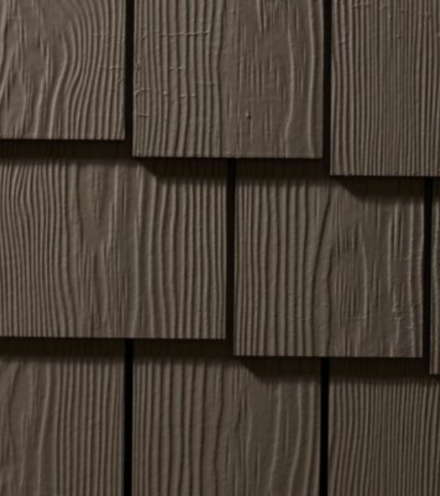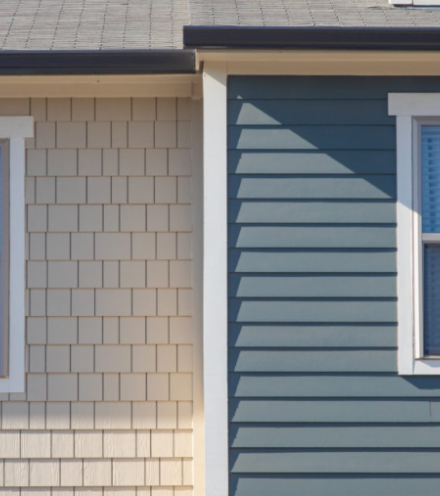Sustainable siding is key for building responsibly in the 21st century, but what environmentally friendly siding options are available? Which eco-friendly exteriors provide the best value? After all, practicality and affordability are big factors when it comes to installing green siding for homes.
The good news is that there are many eco-friendly house siding options available to most builders and everyday homeowners. By comparing the differences between sustainable exterior finishes, homeowners can effectively choose the best sustainable siding for their home or building project.
Take a look as we dive into six of the most popular eco-friendly siding options on the market:

1. Wood
As the saying goes, “If it ain’t broke, don’t fix it!” In many ways, this is true for wood, an eco-friendly exterior that’s as old as time. What makes wood sustainable is that it’s a natural material that does not rely on the creation of new components that are often considered pollutants, like plastics, glues, and chemical finishes. In theory, wood comes from the earth and goes back to the earth. In this way, wood is considered a relatively sustainable exterior siding.
However, there are a few factors involved with using wood. For one, if building projects require logging, it can be detrimental to forestry initiatives. If possible, it’s always best to use reclaimed wood, or timber that has been salvaged from a previous project. In addition, wood is not the best at standing up to the elements. Moisture, sun, and insects can do incredible damage to natural wood siding. For this reason, it requires intensive upkeep and does not have a very long product lifespan, which takes points off its sustainability score.

2. Brick
Brick is another long standing option for eco-house siding that has been around for a long time. There are plenty of brick buildings in small towns across America that date back to the early 20th century. Brick is a sustainable siding option where wood is lacking: longevity. Brick doesn’t have the flammability issues of wood, nor does it fade with sun exposure or rot with moisture. Brick is a sturdy material that is simply better at holding up than wood.
One of the biggest deterrents that modern-day builders face with brick siding is that it requires installation by a professional mason. Brick isn’t an easy material to work with, and if you want it to be installed properly, you’ve got to call in a professional. This can be a big turn-off for homeowners eager to get their hands dirty with easy, eco-friendly siding materials. In addition, brick requires extremely high temperatures for its production, which can raise concerns when assessing it as an eco-friendly siding option.

3. Metal
Metal can be considered an environmentally friendly siding option if it has been repurposed or recycled. Most metal siding has the potential to be recycled again, especially steel and aluminum. This is a huge element to take into consideration when seeking out sustainable exterior finishes.
The biggest drawbacks to this eco-friendly exterior concern the aesthetics. Metal siding simply falls short for many homeowners looking for more modern, stylized designs. Another drawback to metal is that it can dent and chip quite easily ― not great news for those concerned about storm damage.

4. Stone
Natural stone is durable and long-lasting, and scores points for longevity, making it a durable green siding for homes. Most weather threats won’t be any cause for concern with stone siding. Stone is also aesthetically pleasing and stylish, with a beautiful appearance that never goes out of style.
There are two issues with stone, however. First, it requires professional installation, meaning DIY-ers are out of luck. Even more significant is the sourcing of stone. Stone is incredibly heavy, and it must be mined. Depending on where you plan to source the stone, it may have to be transported great distances, which takes a big toll on its sustainability. Longer transportation means more emissions and effort to move the stone from point A to point B, which can ultimately compromise its otherwise eco-friendly qualities.

5. Stucco
Produced without synthetics, stucco is made from all natural ingredients, like sand, water, lime, and Portland cement. These natural resources help it to rank highly as eco-house siding. There are even versions of stucco that cut out the cement, further improving its sustainability factor.
Stucco is a difficult material to work with and will require professional expertise and hired labor. It is also fairly susceptible to the elements and is usually only used for structures located in very dry climates. It is not as heavy-duty as other eco-friendly siding options, and it can also be difficult to recycle and repurpose.

6. Fiber Cement
Fiber cement is made from sand, cement, and wood pulp, all natural materials, and it does not emit toxic fumes when exposed to warm temperatures, as some siding materials like vinyl are known to do. In addition, fiber cement is extremely fire resistant, meaning it is purposefully designed not to spread flames. This adds to its capacity for long-lasting protection, one of the main factors considered when assessing a home for sustainability.
Fiber cement is one of the most versatile eco-friendly siding options when it comes to design quality. For example, Allura fiber cement products are available in three unique styles: lap, board and batten, and shake siding. It gives customers a wider range to choose from for their environmentally-friendly siding projects. There are even fiber cement siding products that capture the look of real wood, so homeowners can get an aesthetic they like while also getting enhanced protection and a long-lasting performance.
Allura fiber cement products make it easy to tick all the boxes, including sustainability and style. Contact us today!




